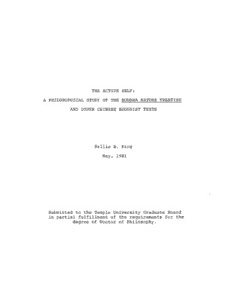
Active Self . A Philosophical Study of the Buddha Nature Treatise and Other Chinese Buddhist Texts PDF
Preview Active Self . A Philosophical Study of the Buddha Nature Treatise and Other Chinese Buddhist Texts
THE ACTIVE SELF: PHILOSOPHICAL STUDY OF THE BUDDHA NATURE TREATISE AND OTHER CHINESE BUDDHIST TEXTS Sallie B. King May, 1981 Submitted to the Temple University Graduate Board in partial fulfillment of the requirements for the degree of Doctor of Philosophy. ◎ Copyright by Sallie Behn King 1981 All Rights Reserved TEMPLE UNIVERSITY GRADUATE BOARD Title of Dissertation: The Active Self : A Philosophical Study of The Buddha Nature Treatise and Other Chinese Buddhist Texts Author: Sallie Behn King .卜 Date submitted to the Graduate Board: M d L L Accepted by the Graduate Board of Temple Univcisity in partial fulfillment of the requirement for lbs degree of Doctor of Philosophy. Dedicated in gratitude to Thomas Dean TAPLE OF CONTENTS ACKNOWLEDGMENTS......................................... vil LIST OF ABBREVIATIONS.................................... ix Chapter 1. INTRODUCTION . . ............................... 1 PART ONE: THE TEXTS 14 2. THE BUDDHA NATURE TREATISE.........................24 A. Introduction and Refutation of Other Views 3o 1. Introduction 2. Refutation of Other Views a. Refuting Hinayana Views: o Buddha Nature Neither Exists 3 Nor Does Not Exist b. Refuting Non-Buddhist l Philosophies: Buddha Nature Is Not an Own-Nature 32 c. Clarification of Mahayana Views: The True Meaning of the Two Truths Doctrine 8 3. Evaluation B. The Essence of Buddha Nature: Bodhicitta, True Nature and Tathagatagarbha 69 1. Introduction 9 2. Analysis 0 a. The Three Causes 20 b. The Three Natures 31 c• Tathagatagarbha 3. Evaluation 7 C. Characteristics of Buddha Naturef I: Action 8 and Non-Substantiality 2 1. Introduction 2 2. Analysis 4 a- Transformation of the Basis 4 b. Dharmakaya and Nirvana 8 c. The Non-Substantiality of Self and Mind 148 3. Evaluation 0 iv 4 5 5 5 6 6 6 6 7 8 8 8 8 9 0 2 V D. Characteristics of Buddha Nature, II: Soteriology 122 1. Introduction 2. Analysis a. The Man-Buddha Relationship 22 b. The Middle Path I c• The Trikaya X 22 3• Evaluation E. Conclusion 122 3• TWO OTHER TEXTS 172 A. The No Increase, No Decrease Sutra 1 72 27 1. Introduction - 7 2 丄1 2. Analytic Summary 1 75 3• Evaluation 1 8 1 44 B. The Supreme Basis Sutra 1 8 9 1. Introduction 丄i- 18 9 2. Analysis 1 69 21 3. Concluding Evaluation 2 2 PART TWO: THE PHILOSOPHY 2T66 ONTOLOGY 2x 9 A. Introduction 219 B. Contra Monism 2122 C. NondualismOther Aspects 25Ü D. Conclusion 258 ACTION 216 A. Introduction 26 B * Action 262 1• The Supreme Basis Sutra 2 2• The Buddha Nature Treatise 264 C. Non-Substantiality 27 0 1• Own-Nature 27 0 2. Mind 27 4 3. Consciousness-Only 277 D, Conclusion 27 9 6. PRACTICE 28o A. Introduction 28 0 B. Analysis 28 1• The Buddha Nature Treatise 281 2• The Supreme Basis Sutra 28 C. Conclusion 29 0 1 9 AT iHHaa: m a iNunaNsa Z6Z L • !«H3 INJmaND^ 0^ anaaHV NVLtHHS iHOnOHLt ON DHIN3S3 anaaHisw ........................................... Z 6 ^ 1 imacpno 耳 toh 26^ 9* 3^.eu Z66 o- dnw tpup eoe a* ma; dosx^TAe apxhp^tou 03 diiauoiueu^i hb^xt^A £05 a* DouoxnsTou ZIL 8* ):ON:) msiON: ihs sionijidivmdis oä anaaHV NVinna *iHonsHi............................................... e i 6 vdd3Naix: anaanv NVinna LiHonDH^ vNa WÄSL.IDISW .......... e e x DtrossvHA ............................................... e ^6 QianoDHVdH^ • • . • «..................................££i ACKNOWLEDGMENTS 工 am indebted to the readers of this study, Professors DeMartino, Kiyota and Yadav for their most helpful comments on the first draft, suggestions which certainly helped strengthen both the conceptualization and the expression of these thoughts. 工 am further obliged tc Professor Kiyota for his help in steering me towards this topic and first stirring my interest in tathagatagarbha thought. He has shown himself to be a wealth of encouragement and moral support throughout the final stages of my studies and a generously beneficent spirit. For these boons 工 am grateful. 工 also owe thanks to the Department of Religion, Temple University, for its generous financial support. In my case this support was especially extraordinary, as the Department proved itself willing to both encourage and support those studies which took me outside the con fines of the Department itself. Thanks are also due Mrs. Marilyn Coyne for typing the first draft of the disser tation f a most ungratifying task, no doubt, with all the foreign words and markings. Certain debts cannot be adequately stated, much less repaid. Such are my debts to Professor Thomas Dean, my vii viii advisor, who has for years selflessly given of himself that 工 might succeed in completing my degree. Given the kind and number of obstacles which 工 have faced over the years, his aid has been both constantly in demand and crucial to my success. He has given enormously of his time, assistance and concern. A bodhisattva of compassion, thoroughly proficient in the skillful means of negotiating a graduate studies path— it has been my very good fortune to have been guided by him. Finally, unending thanks to my husband, Steve. When difficulties in my studies arose, his unshakable confidence in me has always succeeded in returning me to my task. It is thanks to him that we have maintained in our lives the graduate students1 Middle Path: keeping the study foremost (so that it would be accomplished) yet keeping it also in perspective. LIST OF ABBREVIATIONS BNT: Buddha Nature Treatise IBK: Indogaku Bukky^gaku Kenkyu NINDS: No Increase, No Decrease Sutra PEW: Philosophy East and West Ratna•: Ratnagotravibhaga SBS: Supreme Basis Sütra T. : Taisho Shinshu Paiz5kyo
